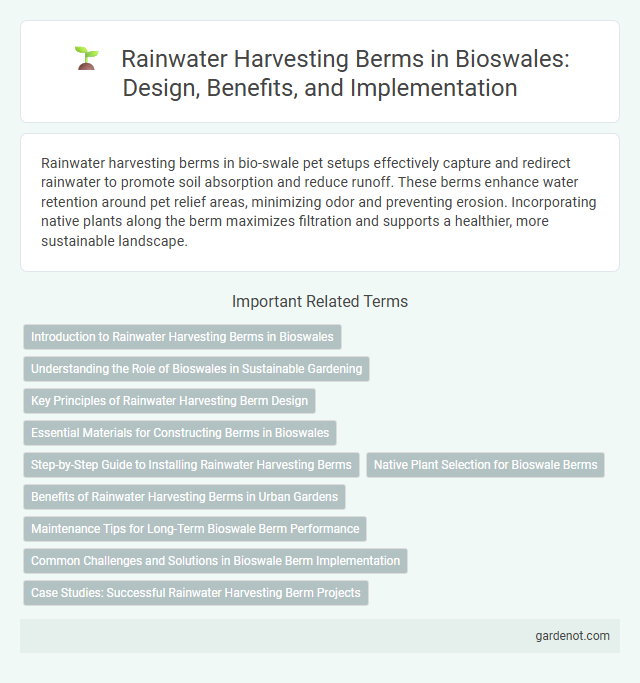Rainwater harvesting berms in bio-swale pet setups effectively capture and redirect rainwater to promote soil absorption and reduce runoff. These berms enhance water retention around pet relief areas, minimizing odor and preventing erosion. Incorporating native plants along the berm maximizes filtration and supports a healthier, more sustainable landscape.
Introduction to Rainwater Harvesting Berms in Bioswales
Rainwater harvesting berms in bioswales are earth mounds designed to capture and direct stormwater runoff, enhancing infiltration and reducing surface erosion. These berms slow down water flow, allowing sediments and pollutants to settle while promoting groundwater recharge. Integrating rainwater harvesting berms in bioswale designs optimizes urban stormwater management by improving water quality and supporting vegetation growth.
Understanding the Role of Bioswales in Sustainable Gardening
Rainwater harvesting berms maximize water retention by directing runoff into bioswales, promoting soil infiltration and reducing erosion. Bioswales use native vegetation and engineered soil layers to filter pollutants, enhancing groundwater quality while supporting plant health. This sustainable gardening approach conserves water resources and mitigates urban flooding by managing stormwater effectively.
Key Principles of Rainwater Harvesting Berm Design
Rainwater harvesting berm design centers on key principles such as contour alignment to capture and slow runoff effectively, soil permeability enhancement to maximize infiltration, and vegetation integration for erosion control and pollutant filtration. Proper berm height and slope gradient optimize water retention without causing overflow or structural failure. Emphasizing these principles ensures efficient rainwater capture, improved groundwater recharge, and reduced surface runoff in bio-swale systems.
Essential Materials for Constructing Berms in Bioswales
Essential materials for constructing rainwater harvesting berms in bioswales include compacted soil with high clay content to ensure water retention and prevent seepage, along with native vegetation to stabilize the berm structure and enhance filtration. Geotextiles are often used to reinforce soil and control erosion, while organic mulch improves moisture retention and supports microbial activity. Incorporating layers of gravel or sand can facilitate proper drainage and prevent waterlogging within the bioswale system.
Step-by-Step Guide to Installing Rainwater Harvesting Berms
Start by selecting a suitable location with gentle slope and good soil permeability to maximize water absorption for the rainwater harvesting berm. Excavate a shallow trench following the contour lines of the land, then shape and compact the berm using excavated soil to create a barrier that directs rainwater towards vegetation or infiltration areas. Finish by planting native vegetation on and around the berm to stabilize the soil, enhance water infiltration, and support ecosystem health.
Native Plant Selection for Bioswale Berms
Native plant selection for bioswale berms enhances rainwater harvesting efficiency by promoting deep root systems that improve soil infiltration and reduce erosion. Species such as Switchgrass (Panicum virgatum), Blue Flag Iris (Iris versicolor), and Joe-Pye Weed (Eutrochium purpureum) are ideal for their drought tolerance and adaptability to fluctuating moisture levels. Utilizing native plants supports local biodiversity, minimizes maintenance costs, and ensures sustainable water management in urban landscapes.
Benefits of Rainwater Harvesting Berms in Urban Gardens
Rainwater harvesting berms in urban gardens effectively capture and retain stormwater, reducing runoff and promoting groundwater recharge. These berms enhance soil moisture levels, support plant health, and decrease the need for supplemental irrigation, contributing to sustainable water management. Incorporating rainwater harvesting berms also mitigates urban flooding and improves water quality by filtering pollutants.
Maintenance Tips for Long-Term Bioswale Berm Performance
Regular inspection and removal of accumulated debris and sediment from the rainwater harvesting berm are essential to maintain optimal water flow and infiltration. Periodic vegetation management, including trimming and replanting native species, supports soil stability and enhances pollutant absorption. Ensuring proper grading and repairing any erosion or damage promptly preserves the berm's structural integrity and long-term bioswale performance.
Common Challenges and Solutions in Bioswale Berm Implementation
Rainwater harvesting berms in bioswales often face challenges such as soil erosion, poor infiltration rates, and maintenance difficulties caused by sediment buildup and vegetation overgrowth. Solutions include using erosion control mats, selecting appropriate permeable soil mixtures, and implementing routine sediment removal and vegetation management schedules. These strategies improve water retention and ensure the long-term functionality and ecological benefits of bioswale berms.
Case Studies: Successful Rainwater Harvesting Berm Projects
Rainwater harvesting berms have demonstrated significant effectiveness in urban and agricultural landscapes by reducing runoff and enhancing groundwater recharge. Case studies from California and Australia highlight how berms integrated with native vegetation have improved soil moisture retention and reduced erosion in arid regions. These projects show measurable increases in water availability for crops and urban green spaces, validating berm design as a sustainable bio-swale component.
Rainwater harvesting berm Infographic

 gardenot.com
gardenot.com